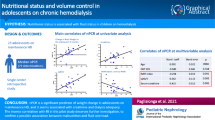Abstract
Background
Normalized protein catabolic rate (nPCR) calculation depends on estimating the urea generation between consecutive hemodialysis (HD) treatments. Two-point nPCR using blood urea nitrogen (BUN) before and after the same HD treatment has not been validated in pediatric patients, who typically receive a more intense HD dose than adults. This study aimed to compare nPCR calculated with a two-point vs. a three-point nPCR model in pediatric HD patients.
Methods
Pediatric patients receiving HD at 2 units were enrolled. Three BUN measurements were obtained around a midweek HD treatment: one prior to HD (preBUN1), one 30 s after HD (30sBUN), and one prior to the subsequent HD (preBUN2). The two-point nPCR model was calculated using preBUN1 and 30sBUN and the three-point nPCR model was calculated using preBUN2 and 30sBUN.
Results
Seventy-six BUN sets from 35 patients were analyzed. Mean age was 16.4 ± 3.5 years. Mean dry weight was 51.4 ± 17.1 kg. Mean spKt/V was 1.54 ± 0.23. Mean preBUN2 was significantly lower than mean preBUN1 (60.2 ± 18.6 vs. 64.0 ± 18.9 mg/dl, p = 0.0001). nPCR obtained from the three-point model was significantly lower than nPCR obtained from the two-point model (1.07 ± 0.31 vs. 1.17 ± 0.31 g/kg/day, p = 0.00001). Seven of 76 (9.2 %) paired comparisons yielded three-point nPCR <1 vs. two-point nPCR >1.
Conclusions
Our data show that in pediatric patients receiving HD, the ((1) two-point and three-point models lead to significantly different nPCRs, and (2) inaccurate protein intake assessment may result from reliance on a two-point model for nPCR estimates.

Similar content being viewed by others
References
Kalantar-Zadeh K, Ikizler TA, Block G, Avram MM, Kopple JD (2003) Malnutrition-inflammation complex syndrome in dialysis patients: causes and consequences. Am J Kidney Dis 42:864–881
Kopple JD (1999) Pathophysiology of protein-energy wasting in chronic renal failure. J Nutr 129:247S–251S
Stenvinkel P, Heimburger O, Paultre F, Diczfalusy U, Wang T, Berglund L, Jogestrand T (1999) Strong association between malnutrition, inflammation, and atherosclerosis in chronic renal failure. Kidney Int 55:1899–1911
McDonald SP, Craig JC (2004) Long-term survival of children with end-stage renal disease. N Engl J Med 350:2654–2662
Groothoff JW, Gruppen MP, Offringa M, Hutten J, Lilien MR, Van De Kar NJ, Wolff ED, Davin JC, Heymans HS (2002) Mortality and causes of death of end-stage renal disease in children: a Dutch cohort study. Kidney Int 61:621–629
Wong CS, Gipson DS, Gillen DL, Emerson S, Koepsell T, Sherrard DJ, Watkins SL, Stehman-Breen C (2000) Anthropometric measures and risk of death in children with end-stage renal disease. Am J Kidney Dis 36:811–819
Wong CS, Hingorani S, Gillen DL, Sherrard DJ, Watkins SL, Brandt JR, Ball A, Stehman-Breen CO (2002) Hypoalbuminemia and risk of death in pediatric patients with end-stage renal disease. Kidney Int 61:630–637
Furth SL, Hwang W, Yang C, Neu AM, Fivush BA, Powe NR (2002) Growth failure, risk of hospitalization and death for children with end-stage renal disease. Pediatr Nephrol 17:450–455
KDOQI Work Group (2009) KDOQI Clinical Practice Guideline for Nutrition in Children with CKD: 2008 update. Executive summary. Am J Kidney Dis 53:S11–S104
Goldstein SL, Sorof JM, Brewer ED (1999) Evaluation and prediction of urea rebound and equilibrated Kt/V in the pediatric hemodialysis population. Am J Kidney Dis 34:49–54
Depner TA, Daugirdas JT (1996) Equations for normalized protein catabolic rate based on two-point modeling of hemodialysis urea kinetics. J Am Soc Nephrol 7:780–785
Daugirdas JT (1989) The post: pre dialysis plasma urea nitrogen ratio to estimate K.t/V and NPCR: validation. Int J Artif Organs 12:420–427
Goldstein SL (2004) Adequacy of dialysis in children: does small solute clearance really matter? Pediatr Nephrol 19:1–5
Daugirdas JT (1993) Second generation logarithmic estimates of single-pool variable volume Kt/V: an analysis of error. J Am Soc Nephrol 4:1205–1213
Goldstein SL, Sorof JM, Brewer ED (1999) Natural logarithmic estimates of Kt/V in the pediatric hemodialysis population. Am J Kidney Dis 33:518–522
Goldstein SL (2001) Hemodialysis in the pediatric patient: state of the art. Adv Ren Replace Ther 8:173–179
Borah MF, Schoenfeld PY, Gotch FA, Sargent JA, Wolfsen M, Humphreys MH (1978) Nitrogen balance during intermittent dialysis therapy of uremia. Kidney Int 14:491–500
Srivaths PR, Wong C, Goldstein SL (2009) Nutrition aspects in children receiving maintenance hemodialysis: impact on outcome. Pediatr Nephrol 24:951–957
Gotch FA, Sargent JA (1985) A mechanistic analysis of the National Cooperative Dialysis Study (NCDS). Kidney Int 28:526–534
Casino FG, Lomonte C, Russo R, Di Iorio B, Chiarulli G, Manno C, Lopez T (1995) A modified Two-BUN method for routine urea modeling: clinical validation in 120 patients on a free diet. Int J Artif Organs 18:553–557
Orellana P, Juarez-Congelosi M, Goldstein SL (2005) Intradialytic parenteral nutrition treatment and biochemical marker assessment for malnutrition in adolescent maintenance hemodialysis patients. J Ren Nutr 15:312–317
Juarez-Congelosi M, Orellana P, Goldstein SL (2007) Normalized protein catabolic rate versus serum albumin as a nutrition status marker in pediatric patients receiving hemodialysis. J Ren Nutr 17:269–274
Author information
Authors and Affiliations
Corresponding author
Rights and permissions
About this article
Cite this article
Srivaths, P.R., Sutherland, S., Alexander, S. et al. Two-point normalized protein catabolic rate overestimates nPCR in pediatric hemodialysis patients. Pediatr Nephrol 28, 797–801 (2013). https://doi.org/10.1007/s00467-012-2371-x
Received:
Revised:
Accepted:
Published:
Issue Date:
DOI: https://doi.org/10.1007/s00467-012-2371-x




